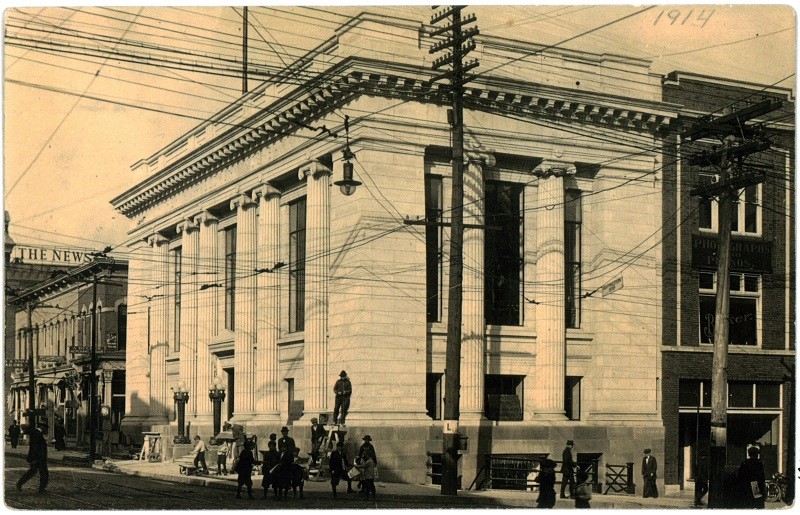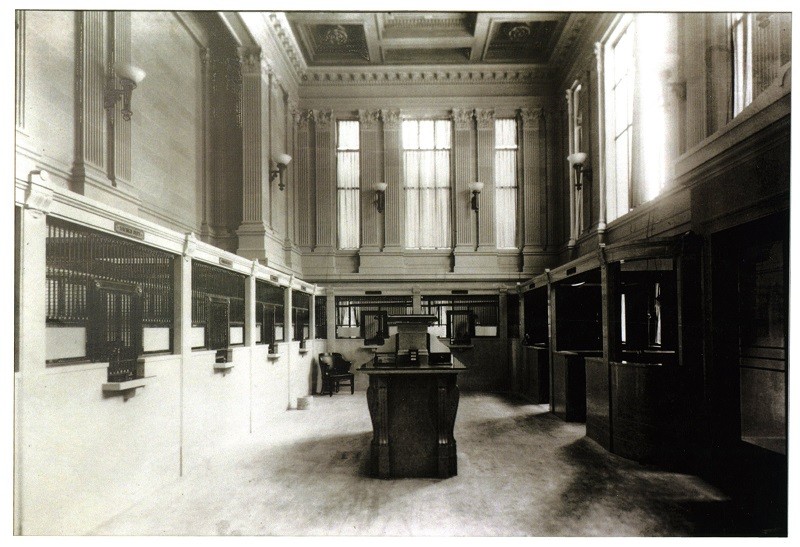Mansfield Savings Bank
Introduction
Text-to-speech Audio
Images
Mansfield Savings Bank near completion in 1914

Interior of Mansfield Savings Bank

Backstory and Context
Text-to-speech Audio
In an article in the February 5, 1967 edition of the Mansfield News Journal, Paul L. White wrote about the beginnings of the Mansfield Savings Bank and the economic conditions present in the city of Mansfield at the time of its inception. During the depression, following the Civil War, people lost faith in banks and the leading bank in Mansfield closed. Citizens began hiding their money in their homes leading to an uptick in robberies and the occasional incident of someone burning their money in their stove, forgetting it was hidden there. A few leading men of Mansfield worked up the nerve to start a bank in early 1873: Michael D. Harter of Aultman & Taylor, Gen. Roeliff Brinkerhoff, Col. Barnabus Burns, and others. There were 110 original stockholders and the bank was capitalized for $32,500. They purchased the lot on the corner of Fourth and Main, known as Lamberton Corner, and began construction of the bank building.
On Wednesday, October 15, 1873, the bank officially opened for business. The following week the Ohio Liberal newspaper described the building as being “renaissance style, two stories in height, with Mansard roof. The beautiful design is the work of Mr. A. B. Alger, who is fast gaining a reputation as an architect, equaled by none in the state.” The rooms inside were “elegantly finished, with the best seasoned walnut, some of which was taken from the old barn, formally standing on the ‘Johns’ homestead near the old junction, and is probably upwards to 50 years old.” This seasoned walnut would eventually make it into the home of Mary B. Gilbert, the granddaughter of Roeliff Brinkerhoff. The building was remodeled in 1888 completely changing the appearance. An addition was made to the rear and the Mansard roof was removed and replaced with gables and a turret. The building served the bank well for 40 years.
On June 10, 1912, the Mansfield Savings Bank acquired the building directly to the north of the bank from the Martin Frank estate. Charles F. Ackerman, president of the bank at the time, said both buildings would be torn down and a new bank would be built in its place. Early rumors were that a modern, fireproof, seven-story business block would be built. On December 17, 1912, the Mansfield News published the description and an image of the proposed structure. The $100,000 building, designed by local architect Vernon Redding, would be “one of the finest in the state,” constructed of reinforced concrete and granite. It would be one story with a basement and mezzanine. In April of 1913, construction began on the building to the north of the site of the new bank building to temporarily house the bank during construction. Once they moved into their temporary location on July 12, 1913, the razing of the two buildings on the corner began.
On September 18, 1913, with no celebration, the cornerstone of the new Mansfield Savings Bank was laid. A copper box containing photographs, newspapers, almanacs, and a history of the bank was included. This may have been the most-watched construction of a building in the city’s history as hundreds of people stopped daily to check the progress. Many passed the structure while conducting their daily business, but many were also drawn to witness the construction methods used. This included the use of two big derricks, placed in the center of the building, which was used to hoist blocks of stone and materials. On July 31, 1913, one derrick, being used during excavation, fell to the ground. Luckily no one was injured. On New Year’s Day, 1915, the bank was opened for public inspection and many marveled at the beauty of the structure. The building is in the style of Italian Renaissance architecture. “The exterior of the building is constructed of Concord granite, and from the base up to the bottom of the big columns … the granite is polished so that it will not be marred by any scratch that might be put upon it.”
In 1953 the Mansfield Savings Trust National Bank combined with Citizens National Bank and Trust Company to create the First National Bank of Mansfield. After an addition to the former Citizens National Bank, the banking facilities were consolidated to one location, and Mansfield Savings Bank was sold. The building was placed on the National Register of Historic Places in 1986.
Sources
Mansfield News Journal, 05 FEB 1967, p. 5D.
The Ohio Liberal, 22 OCT 1873, p. 3.
Mansfield News, 20 SEP 1913, p. 4.
Mansfield News, 11 JUN 1912, p. 4.
Mansfield News, 15 JUN 1912, p. 3.
Mansfield News, 10 JAN 1913, p. 5.
Mansfield News, 17 DEC 1912, p. 8.
Mansfield News, 12 JUL 1913, p. 3.
Mansfield News, 20 SEP 1913, p. 4.
Mansfield News, 06 DEC 1913, p. 12.
Mansfield News, 01 AUG 1913, p. 9.
Mansfield News, 02 JAN 1915, p. 4.
Ohio SP Mansfield Savings Bank. The National Archives, https://catalog.archives.gov/id/71991094
Landmarks of Mansfield: Mansfield Savings Bank Building, https://1812blockhouse.com/landmarks-of-richland/landmarks-of-mansfield-mansfield-savings-bank-building/
